Page 1249 of 3371
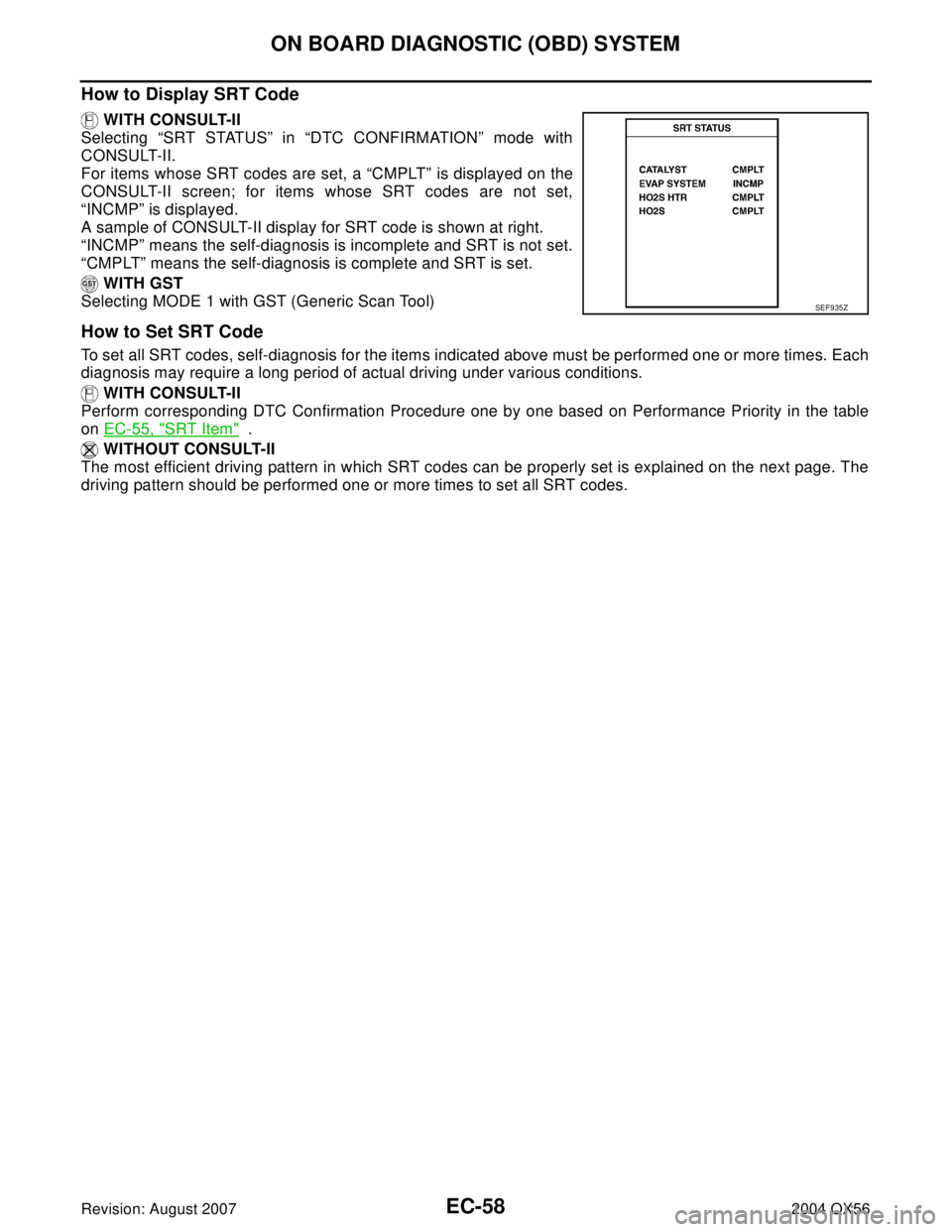
EC-58Revision: August 2007
ON BOARD DIAGNOSTIC (OBD) SYSTEM
2004 QX56
How to Display SRT Code
WITH CONSULT-II
Selecting “SRT STATUS” in “DTC CONFIRMATION” mode with
CONSULT-II.
For items whose SRT codes are set, a “CMPLT” is displayed on the
CONSULT-II screen; for items whose SRT codes are not set,
“INCMP” is displayed.
A sample of CONSULT-II display for SRT code is shown at right.
“INCMP” means the self-diagnosis is incomplete and SRT is not set.
“CMPLT” means the self-diagnosis is complete and SRT is set.
WITH GST
Selecting MODE 1 with GST (Generic Scan Tool)
How to Set SRT Code
To set all SRT codes, self-diagnosis for the items indicated above must be performed one or more times. Each
diagnosis may require a long period of actual driving under various conditions.
WITH CONSULT-II
Perform corresponding DTC Confirmation Procedure one by one based on Performance Priority in the table
on EC-55, "
SRT Item" .
WITHOUT CONSULT-II
The most efficient driving pattern in which SRT codes can be properly set is explained on the next page. The
driving pattern should be performed one or more times to set all SRT codes.
SEF 9 35 Z
Page 1262 of 3371
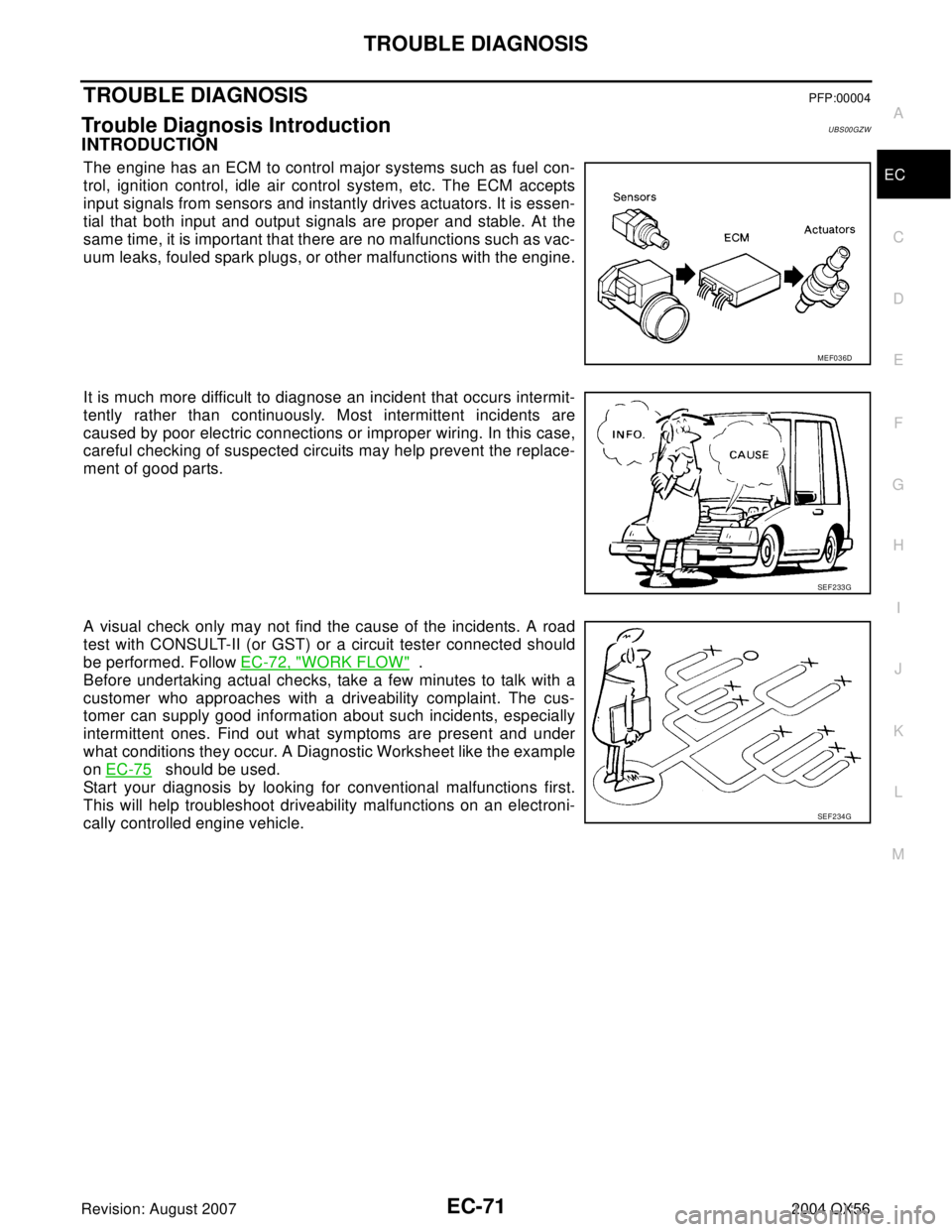
TROUBLE DIAGNOSIS
EC-71
C
D
E
F
G
H
I
J
K
L
MA
EC
Revision: August 20072004 QX56
TROUBLE DIAGNOSISPFP:00004
Trouble Diagnosis IntroductionUBS00GZW
INTRODUCTION
The engine has an ECM to control major systems such as fuel con-
trol, ignition control, idle air control system, etc. The ECM accepts
input signals from sensors and instantly drives actuators. It is essen-
tial that both input and output signals are proper and stable. At the
same time, it is important that there are no malfunctions such as vac-
uum leaks, fouled spark plugs, or other malfunctions with the engine.
It is much more difficult to diagnose an incident that occurs intermit-
tently rather than continuously. Most intermittent incidents are
caused by poor electric connections or improper wiring. In this case,
careful checking of suspected circuits may help prevent the replace-
ment of good parts.
A visual check only may not find the cause of the incidents. A road
test with CONSULT-II (or GST) or a circuit tester connected should
be performed. Follow EC-72, "
WORK FLOW" .
Before undertaking actual checks, take a few minutes to talk with a
customer who approaches with a driveability complaint. The cus-
tomer can supply good information about such incidents, especially
intermittent ones. Find out what symptoms are present and under
what conditions they occur. A Diagnostic Worksheet like the example
on EC-75
should be used.
Start your diagnosis by looking for conventional malfunctions first.
This will help troubleshoot driveability malfunctions on an electroni-
cally controlled engine vehicle.
MEF036D
SEF 2 33 G
SEF 2 34 G
Page 1270 of 3371
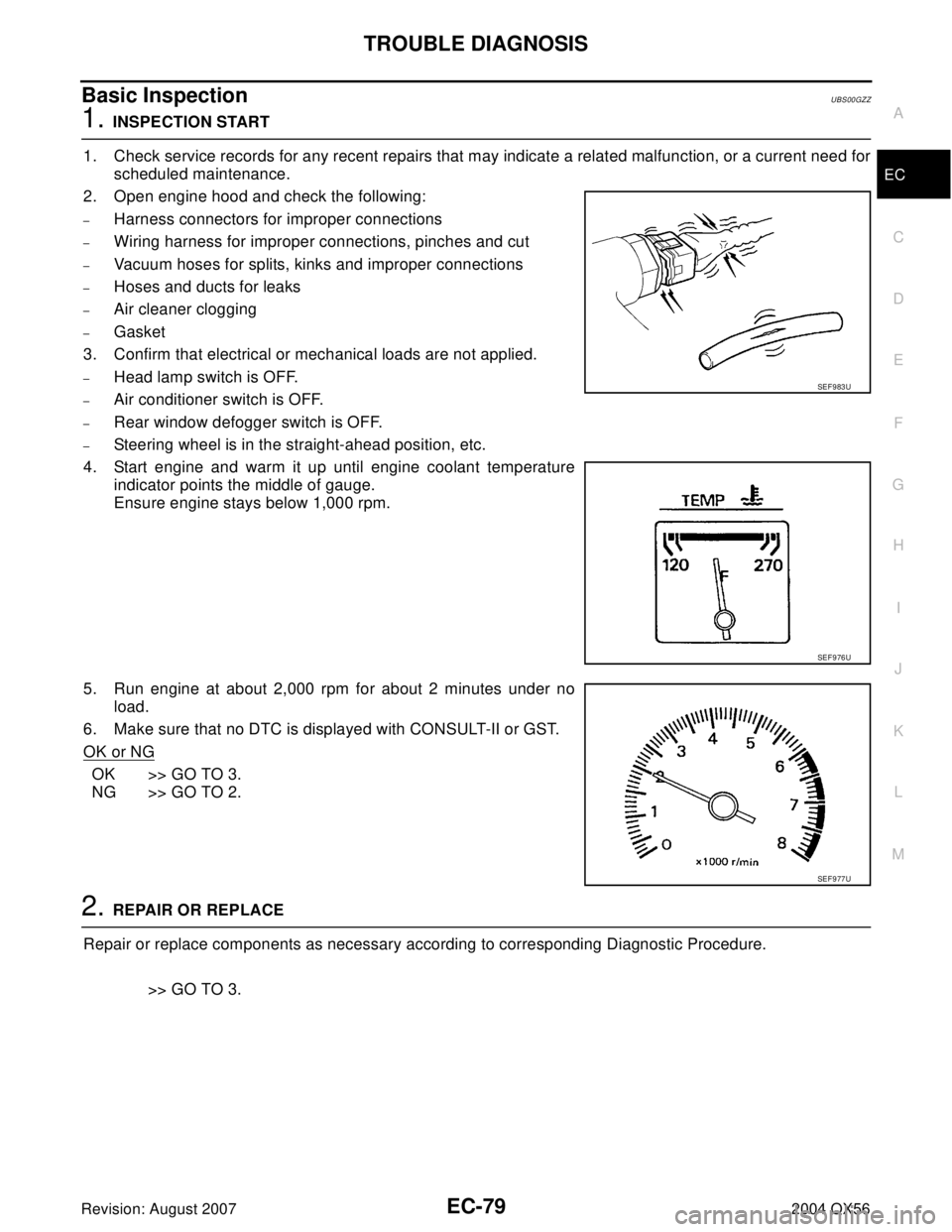
TROUBLE DIAGNOSIS
EC-79
C
D
E
F
G
H
I
J
K
L
MA
EC
Revision: August 20072004 QX56
Basic InspectionUBS00GZZ
1. INSPECTION START
1. Check service records for any recent repairs that may indicate a related malfunction, or a current need for
scheduled maintenance.
2. Open engine hood and check the following:
–Harness connectors for improper connections
–Wiring harness for improper connections, pinches and cut
–Vacuum hoses for splits, kinks and improper connections
–Hoses and ducts for leaks
–Air cleaner clogging
–Gasket
3. Confirm that electrical or mechanical loads are not applied.
–Head lamp switch is OFF.
–Air conditioner switch is OFF.
–Rear window defogger switch is OFF.
–Steering wheel is in the straight-ahead position, etc.
4. Start engine and warm it up until engine coolant temperature
indicator points the middle of gauge.
Ensure engine stays below 1,000 rpm.
5. Run engine at about 2,000 rpm for about 2 minutes under no
load.
6. Make sure that no DTC is displayed with CONSULT-II or GST.
OK or NG
OK >> GO TO 3.
NG >> GO TO 2.
2. REPAIR OR REPLACE
Repair or replace components as necessary according to corresponding Diagnostic Procedure.
>> GO TO 3.
SEF 9 83 U
SEF 9 76 U
SEF 9 77 U
Page 1304 of 3371
TROUBLE DIAGNOSIS
EC-113
C
D
E
F
G
H
I
J
K
L
MA
EC
Revision: August 20072004 QX56
DTC Work Support Mode
*: DTC P1442 and P1456 does not apply to JA60 models but appears in DTC Work Support Mode screens.Test mode Test item Condition Reference page
EVAPORATIVE SYSTEMPURGE FLOW P0441
Refer to corresponding
trouble diagnosis for DTC.EC-271
EVAP SML LEAK P0442/P1442*EC-276
EVAP V/S SML LEAK P0456/P1456*EC-324
PURG VOL CN/V P1444EC-496
A/F SEN1A/F SEN1 (B1) P1276EC-463A/F SEN1 (B2) P1286EC-463
A/F SEN1 (B1) P1278/P1279EC-472, EC-484
A/F SEN1 (B2) P1288/1289EC-472, EC-484
H02S2HO2S2 (B1) P0139EC-196
HO2S2 (B1) P1146EC-383
HO2S2 (B1) P1147EC-395
HO2S2 (B2) P0159EC-196
HO2S2 (B2) P1166EC-383
HO2S2 (B2) P1167EC-395
Page 1306 of 3371
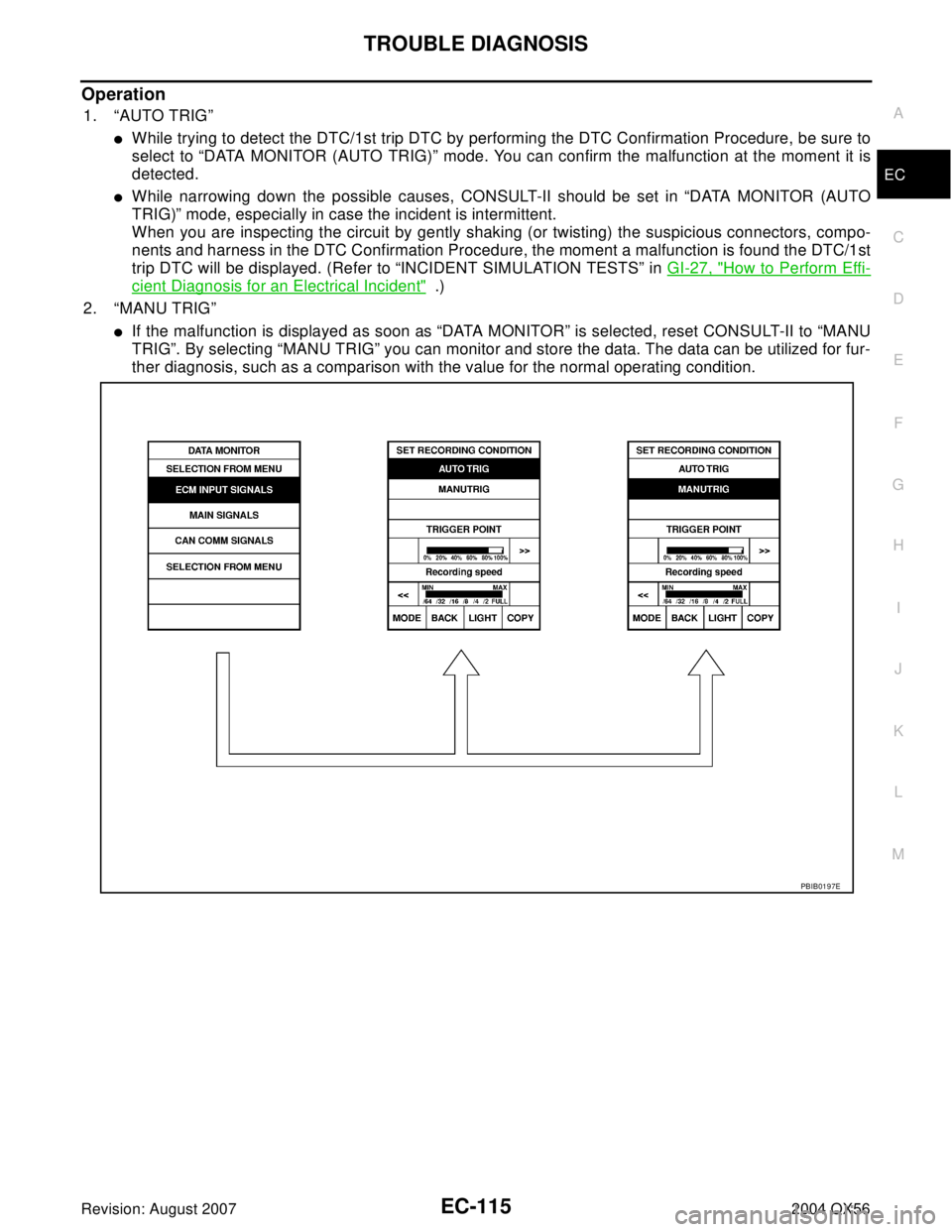
TROUBLE DIAGNOSIS
EC-115
C
D
E
F
G
H
I
J
K
L
MA
EC
Revision: August 20072004 QX56
Operation
1. “AUTO TRIG”
�While trying to detect the DTC/1st trip DTC by performing the DTC Confirmation Procedure, be sure to
select to “DATA MONITOR (AUTO TRIG)” mode. You can confirm the malfunction at the moment it is
detected.
�While narrowing down the possible causes, CONSULT-II should be set in “DATA MONITOR (AUTO
TRIG)” mode, especially in case the incident is intermittent.
When you are inspecting the circuit by gently shaking (or twisting) the suspicious connectors, compo-
nents and harness in the DTC Confirmation Procedure, the moment a malfunction is found the DTC/1st
trip DTC will be displayed. (Refer to “INCIDENT SIMULATION TESTS” in GI-27, "
How to Perform Effi-
cient Diagnosis for an Electrical Incident" .)
2. “MANU TRIG”
�If the malfunction is displayed as soon as “DATA MONITOR” is selected, reset CONSULT-II to “MANU
TRIG”. By selecting “MANU TRIG” you can monitor and store the data. The data can be utilized for fur-
ther diagnosis, such as a comparison with the value for the normal operating condition.
PBIB0197E
Page 1329 of 3371

EC-138Revision: August 2007
DTC P0037, P0038, P0057, P0058 HO2S2 HEATER
2004 QX56
DTC P0037, P0038, P0057, P0058 HO2S2 HEATERPFP:226A0
DescriptionUBS00H0N
SYSTEM DESCRIPTION
The ECM performs ON/OFF control of the heated oxygen sensor 2 heater corresponding to the engine speed,
amount of intake air and engine coolant temperature.
OPERATION
CONSULT-II Reference Value in Data Monitor ModeUBS00H0O
Specification data are reference values.
On Board Diagnosis LogicUBS00H0P
Sensor Input signal to ECM ECM function Actuator
Camshaft position sensor (PHASE)
Crankshaft position sensor (POS)Engine speed
Heated oxygen sensor 2
heater controlHeated oxygen sensor 2 heater
Engine coolant temperature sensor Engine coolant temperature
Mass air flow sensor Amount of intake air
Engine speed rpm Heated oxygen sensor 2 heater
Above 3,600OFF
Below 3,600 rpm after the following conditions are met.
�Engine: After warming up
�Keeping the engine speed between 3,500 and 4,000 rpm for 1
minute and at idle for 1 minute under no loadON
MONITOR ITEM CONDITION SPECIFICATION
HO2S2 HTR (B1)
HO2S2 HTR (B2)
�Engine speed is below 3,600 rpm after the following conditions are met.
–Engine: After warming up
–Keeping the engine speed between 3,500 and 4,000 rpm for 1 minute and
at idle for 1 minute under no loadON
�Engine speed: Above 3,600 rpm OFF
DTC No. Trouble diagnosis name DTC detecting condition Possible cause
P0037
0037
(Bank 1)
Heated oxygen sensor 2
heater control circuit lowThe current amperage in the heated oxygen sen-
sor 2 heater circuit is out of the normal range.
(An excessively low voltage signal is sent to ECM
through the heated oxygen sensor 2 heater.)
�Harness or connectors
(The heated oxygen sensor 2 heater
circuit is open or shorted.)
�Heater oxygen sensor 2 heater P0057
0057
(Bank 2)
P0038
0038
(Bank 1)
Heated oxygen sensor 2
heater control circuit highThe current amperage in the heated oxygen sen-
sor 2 heater circuit is out of the normal range.
(An excessively high voltage signal is sent to
ECM through the heated oxygen sensor 2
heater.)
�Harness or connectors
(The heated oxygen sensor 2 heater
circuit is shorted.)
�Heater oxygen sensor 2 heater P0058
0058
(Bank 2)
Page 1338 of 3371
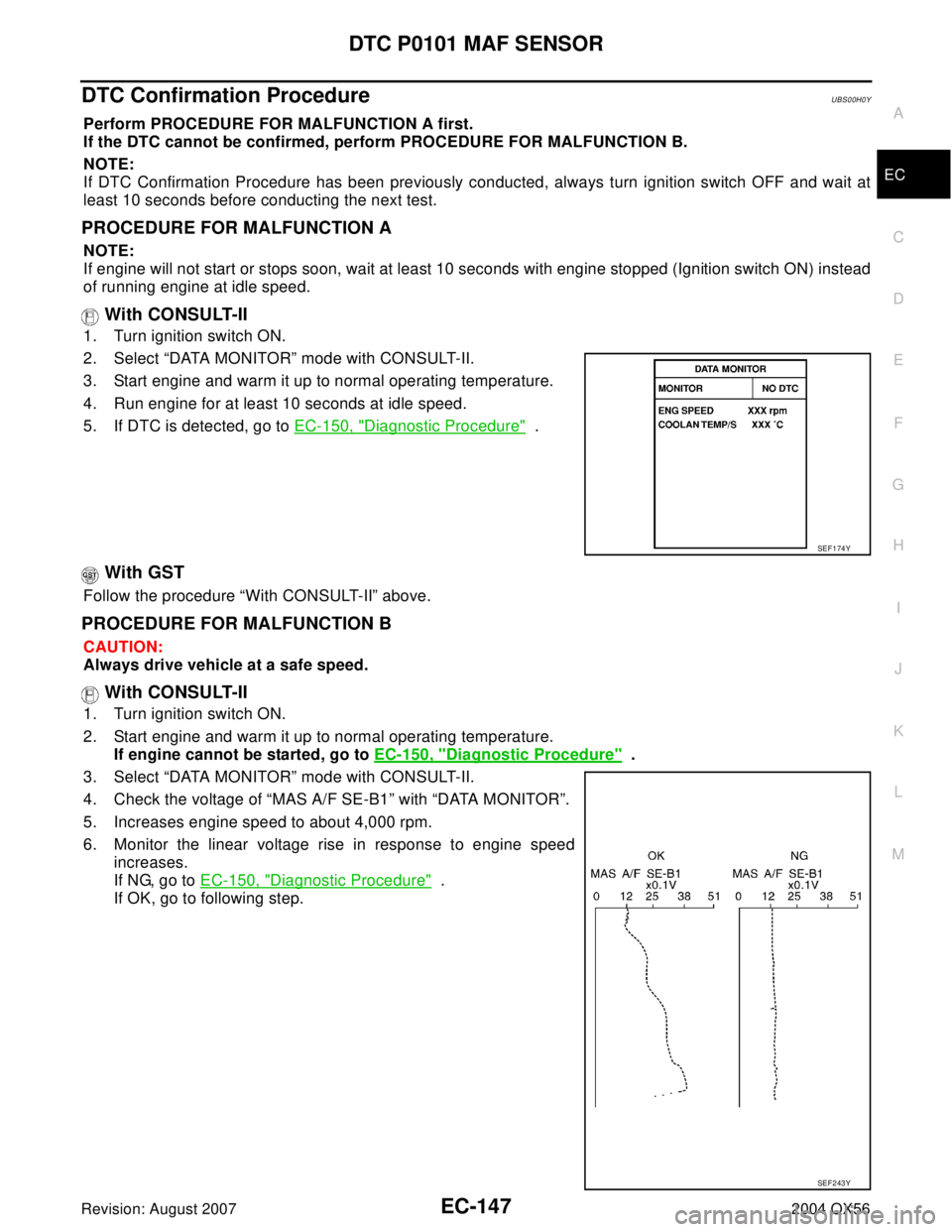
DTC P0101 MAF SENSOR
EC-147
C
D
E
F
G
H
I
J
K
L
MA
EC
Revision: August 20072004 QX56
DTC Confirmation ProcedureUBS00H0Y
Perform PROCEDURE FOR MALFUNCTION A first.
If the DTC cannot be confirmed, perform PROCEDURE FOR MALFUNCTION B.
NOTE:
If DTC Confirmation Procedure has been previously conducted, always turn ignition switch OFF and wait at
least 10 seconds before conducting the next test.
PROCEDURE FOR MALFUNCTION A
NOTE:
If engine will not start or stops soon, wait at least 10 seconds with engine stopped (Ignition switch ON) instead
of running engine at idle speed.
With CONSULT-II
1. Turn ignition switch ON.
2. Select “DATA MONITOR” mode with CONSULT-II.
3. Start engine and warm it up to normal operating temperature.
4. Run engine for at least 10 seconds at idle speed.
5. If DTC is detected, go to EC-150, "
Diagnostic Procedure" .
With GST
Follow the procedure “With CONSULT-II” above.
PROCEDURE FOR MALFUNCTION B
CAUTION:
Always drive vehicle at a safe speed.
With CONSULT-II
1. Turn ignition switch ON.
2. Start engine and warm it up to normal operating temperature.
If engine cannot be started, go to EC-150, "
Diagnostic Procedure" .
3. Select “DATA MONITOR” mode with CONSULT-II.
4. Check the voltage of “MAS A/F SE-B1” with “DATA MONITOR”.
5. Increases engine speed to about 4,000 rpm.
6. Monitor the linear voltage rise in response to engine speed
increases.
If NG, go to EC-150, "
Diagnostic Procedure" .
If OK, go to following step.
SEF 1 74 Y
SEF 2 43 Y
Page 1339 of 3371
EC-148Revision: August 2007
DTC P0101 MAF SENSOR
2004 QX56
7. Maintain the following conditions for at least 10 consecutive sec-
onds.
8. If DTC is detected, go to EC-150, "
Diagnostic Procedure" .
Overall Function CheckUBS00H0Z
PROCEDURE FOR MALFUNCTION B
Use this procedure to check the overall function of the mass air flow sensor circuit. During this check, a DTC
might not be confirmed.
With GST
1. Start engine and warm it up to normal operating temperature.
2. Select MODE 1 with GST.
3. Check the mass air flow sensor signal with MODE 1.
4. Check for linear mass air flow sensor signal value rise in
response to increases to about 4,000 rpm in engine speed.
5. If NG, go to EC-150, "
Diagnostic Procedure" .
ENG SPEED More than 2,000 rpm
THRTL SEN 1 More than 3V
THRTL SEN 2 More than 3V
Selector lever Suitable position
Driving locationDriving vehicle uphill (Increased engine load) will help
maintain the driving conditions required for this test.
PBIB0199E
SEF 5 34 P